Enteromorpha prolifera Polysaccharides Alleviate Valproic Acid-Induced Neuronal Apoptosis in a Cellular Model of Autism Spectrum Disorder
Abstract
1. Introduction
2. Materials and Methods
2.1. Extraction of Polysaccharides from Enteromorpha prolifera
2.2. Analysis of the Monosaccharide Structure of PEPs
2.3. Determination of PEPs Molecular Mass
2.4. The Infrared Characteristic Spectrum of PEPs
2.5. Network Pharmacology Analysis
2.6. Protein–Protein Interaction (PPI) Network Analysis
2.7. Gene Ontology (GO) and Kyoto Encyclopedia of Genes and Genomes (KEGG) Pathway Enrichment Analysis
2.8. MCODE Analysis
2.9. Molecular Docking
2.10. Cell Models and Drug Interventions
2.10.1. Cell Culture
2.10.2. CCK-8 Assay
2.10.3. Effects of PEPs on VPA-Induced Neuronal Apoptosis
2.10.4. Western Blotting
2.11. Statistical Analysis
3. Results
3.1. Monosaccharide Composition of PEPs
3.2. Molecular Weight of PEPs
3.3. Analysis of PEPs Using Infrared Spectroscopy
3.4. Analysis of Potential ASD-Related PEPs Targets
3.4.1. Screening the Main Active Components of PEPs
3.4.2. PPI Network Analysis Results
3.5. Functional Enrichment Analysis of ASD-Related PEPs Targets
3.6. MCODE Analysis of ASD-Related PEPs Targets
3.7. Molecular Docking Analysis Results
3.8. PEPs Suppresses VPA-Induced Cytotoxicity in HT22 Cells
3.9. PEPs Suppresses VPA-Induced Apoptosis in the HT22 Cells
3.10. Effect of PEPs on the Modulation of Critical Target Proteins in HT22 Cells
4. Discussion
5. Conclusions
Supplementary Materials
Author Contributions
Funding
Institutional Review Board Statement
Informed Consent Statement
Data Availability Statement
Conflicts of Interest
Abbreviations
| PEPs | Enteromorpha prolifera polysaccharide |
| ASD | autism spectrum disorder |
| VPA | valproic acid |
References
- Association, A.P. Diagnostic and Statistical Manual of Mental Disorders, 5th ed.; American Psychiatric Publishing: Washington, DC, USA, 2013. [Google Scholar]
- Shaw, K.A.; Williams, S.; Patrick, M.E.; Valencia-Prado, M.; Durkin, M.S.; Howerton, E.M.; Ladd-Acosta, C.M.; Pas, E.T.; Bakian, A.V.; Bartholomew, P.; et al. Prevalence and Early Identification of Autism Spectrum Disorder Among Children Aged 4 and 8 Years—Autism and Developmental Disabilities Monitoring Network, 16 Sites, United States, 2022. Morb. Mortal. Wkly. Rep. Surveill. Summ. 2025, 74, 1–22. [Google Scholar] [CrossRef]
- Kompella, S.; Vittori, A.; Kroin, J.; Kaushal, S.; Khan, S.; Neuhut, S. Impact of Antipsychotic Use on Readmission Rates in Children and Adolescents With Autism Spectrum Disorder and Irritability. Cureus 2022, 14, e22361. [Google Scholar] [CrossRef]
- Williams, K.; Brignell, A.; Randall, M.; Silove, N.; Hazell, P. Selective serotonin reuptake inhibitors (SSRIs) for autism spectrum disorders (ASD). Cochrane Database Syst. Rev. 2013, 2013, Cd004677. [Google Scholar] [CrossRef]
- Salloum-Asfar, S.; Zawia, N.; Abdulla, S.A. Retracing our steps: A review on autism research in children, its limitation and impending pharmacological interventions. Pharmacol. Ther. 2024, 253, 108564. [Google Scholar] [CrossRef]
- Pardo, C.A.; Eberhart, C.G. The neurobiology of autism. Brain Pathol. 2007, 17, 434–447. [Google Scholar] [CrossRef]
- Patterson, P.H. Immune involvement in schizophrenia and autism: Etiology, pathology and animal models. Behav. Brain Res. 2009, 204, 313–321. [Google Scholar] [CrossRef] [PubMed]
- Brown, A.S.; Meyer, U. Maternal Immune Activation and Neuropsychiatric Illness: A Translational Research Perspective. Am. J. Psychiatry 2018, 175, 1073–1083. [Google Scholar] [CrossRef]
- Zhou, X.; Xia, X.; Li, L.; Ye, Y.; Chen, Q.; Ke, M.; Cui, Q.; He, Y.; Chen, Y.; Lin, S.; et al. Evaluation of Heavy Metals and Essential Minerals in the Hair of Children with Autism Spectrum Disorder and Their Association with Symptom Severity. Biol. Trace Elem. Res. 2025; online ahead of print. [Google Scholar] [CrossRef]
- Bromley, R.L.; Mawer, G.E.; Briggs, M.; Cheyne, C.; Clayton-Smith, J.; García-Fiñana, M.; Kneen, R.; Lucas, S.B.; Shallcross, R.; Baker, G.A. The prevalence of neurodevelopmental disorders in children prenatally exposed to antiepileptic drugs. J. Neurol. Neurosurg. Psychiatry 2013, 84, 637–643. [Google Scholar] [CrossRef] [PubMed]
- Vasconcelos, Q.; Serafini, M.A.; Carletti, J.V.; Aragão, G.F.; Gottfried, C.; Bambini-Junior, V. Valproate Exposure as an In vitro Model for Studying Morpho-Molecular Features of ASD: A Systematic Review. CNS Neurol. Disord. Drug Targets 2025, 24, 766–778. [Google Scholar] [CrossRef]
- Liu, L.; Zhou, X.; Ma, Z.; Liu, R.; Zhang, Y.; Wang, Y.; Liu, Y.; Xia, X.; Wang, J. Hippocampal Proteomics Reveals the Novel Molecular Profiling of Postnatal Lead (Pb) Exposure on Autism-like Behaviors. Toxics 2025, 13, 465. [Google Scholar] [CrossRef] [PubMed]
- Dong, D.; Zielke, H.R.; Yeh, D.; Yang, P. Cellular stress and apoptosis contribute to the pathogenesis of autism spectrum disorder. Autism Res. 2018, 11, 1076–1090. [Google Scholar] [CrossRef]
- Młynarska, E.; Barszcz, E.; Budny, E.; Gajewska, A.; Kopeć, K.; Wasiak, J.; Rysz, J.; Franczyk, B. The Gut-Brain-Microbiota Connection and Its Role in Autism Spectrum Disorders. Nutrients 2025, 17, 1135. [Google Scholar] [CrossRef]
- Hughes, H.K.; Moreno, R.J.; Ashwood, P. Innate immune dysfunction and neuroinflammation in autism spectrum disorder (ASD). Brain Behav. Immun. 2023, 108, 245–254. [Google Scholar] [CrossRef]
- Davinelli, S.; Medoro, A.; Siracusano, M.; Savino, R.; Saso, L.; Scapagnini, G.; Mazzone, L. Oxidative stress response and NRF2 signaling pathway in autism spectrum disorder. Redox Biol. 2025, 83, 103661. [Google Scholar] [CrossRef] [PubMed]
- Nisar, S.; Bhat, A.A.; Masoodi, T.; Hashem, S.; Akhtar, S.; Ali, T.A.; Amjad, S.; Chawla, S.; Bagga, P.; Frenneaux, M.P.; et al. Genetics of glutamate and its receptors in autism spectrum disorder. Mol. Psychiatry 2022, 27, 2380–2392. [Google Scholar] [CrossRef]
- Taskin, E. A summary of reports of Ulvaceae (Chlorophyta) from Turkey. Pak. J. Biol. Sci. 2007, 10, 1934–1937. [Google Scholar] [CrossRef]
- Guo, F.; Zhuang, X.; Han, M.; Lin, W. Polysaccharides from Enteromorpha prolifera protect against carbon tetrachloride-induced acute liver injury in mice via activation of Nrf2/HO-1 signaling, and suppression of oxidative stress, inflammation and apoptosis. Food Funct. 2020, 11, 4485–4498. [Google Scholar] [CrossRef] [PubMed]
- Wang, X.; Chen, Y.; Wang, J.; Liu, Z.; Zhao, S. Antitumor activity of a sulfated polysaccharide from Enteromorpha intestinalis targeted against hepatoma through mitochondrial pathway. Tumour Biol. 2014, 35, 1641–1647. [Google Scholar] [CrossRef] [PubMed]
- Ouyang, Y.; Liu, D.; Zhang, L.; Li, X.; Chen, X.; Zhao, C. Green Alga Enteromorpha prolifera Oligosaccharide Ameliorates Ageing and Hyperglycemia through Gut-Brain Axis in Age-Matched Diabetic Mice. Mol. Nutr. Food Res. 2022, 66, e2100564. [Google Scholar] [CrossRef]
- Ren, R.; Gong, J.; Zhao, Y.; Zhuang, X.; Ye, Y.; Huang, F.; Lin, W. Sulfated polysaccharide from Enteromorpha prolifera suppresses SREBP-1c and ACC expression to lower serum triglycerides in high-fat diet-induced hyperlipidaemic rats. J. Funct. Foods 2018, 40, 722–728. [Google Scholar] [CrossRef]
- Qi, X.; Mao, W.; Gao, Y.; Chen, Y.; Chen, Y.; Zhao, C.; Li, N.; Wang, C.; Yan, M.; Lin, C.; et al. Chemical characteristic of an anticoagulant-active sulfated polysaccharide from Enteromorpha clathrata. Carbohydr. Polym. 2012, 90, 1804–1810. [Google Scholar] [CrossRef]
- Liu, D.; Zhao, C.; Lin, G.; Wu, D. The Anti-tumor and Immumoregulatory Effect of Green Seaweed Ulva Lactuca Polysaccharides on Mice. Free Radic. Biol. Med. 2019, 145, S71. [Google Scholar] [CrossRef]
- Liu, X.Y.; Liu, D.; Lin, G.P.; Wu, Y.J.; Gao, L.Y.; Ai, C.; Huang, Y.F.; Wang, M.F.; El-Seedi, H.R.; Chen, X.H.; et al. Anti-ageing and antioxidant effects of sulfate oligosaccharides from green algae Ulva lactuca and Enteromorpha prolifera in SAMP8 mice. Int. J. Biol. Macromol. 2019, 139, 342–351. [Google Scholar] [CrossRef] [PubMed]
- Olasehinde, T.A.; Olaniran, A.O.; Okoh, A.I. Sulfated polysaccharides of some seaweeds exhibit neuroprotection via mitigation of oxidative stress, cholinergic dysfunction and inhibition of Zn—Induced neuronal damage in HT-22 cells. BMC Complement. Med. Ther. 2020, 20, 251. [Google Scholar] [CrossRef] [PubMed]
- Tian, J.; Fu, C.; Li, Y.; Lu, P.; Li, Z.; Qin, X.; Jin, S. Network toxicological mechanism analysis of pyrethroid insecticides-induced chronic respiratory system damage in humans. Ecotoxicol. Environ. Saf. 2025, 303, 118828. [Google Scholar] [CrossRef] [PubMed]
- Cheng, S.; Xin, J.; Zhang, T.; Zhang, Y.; Ji, C.; Kang, L.; Zhu, X.; Zhang, H.; Wang, W.; Liao, X. Assessing the potential impact of salidroside on Chikungunya virus-induced acute interstitial nephritis via network pharmacology, molecular docking and in vitro experiments. Front. Cell. Infect. Microbiol. 2025, 15, 1623860. [Google Scholar] [CrossRef]
- Wang, J.; Chen, Y.; Fan, H.; Gao, C.; Feng, G.; Zhao, Y.; Zhang, S.; An, Q.; Ding, X.; Wang, S.; et al. Studies Combining Network Pharmacology with In Vivo Experiments Uncover the Fever-reducing Effects and Underlying Molecular Pathways of Radix Isatidis. Comb. Chem. High Throughput Screen. 2025; in press. [Google Scholar] [CrossRef]
- Desai, V.; Shaikhsurab, M.Z.; Varghese, N.; Ashtekar, H. Molecular docking and network pharmacology study on active compounds of Cyprus rotundus for the treatment of diabetes mellitus. Silico Pharmacol. 2024, 12, 98. [Google Scholar] [CrossRef]
- Pan, B.; Chen, F.; Shen, S.; Jiang, Y.; Yang, Y.; Wang, J.; Liu, Y.; Wei, L.; Liu, J.; Kong, G.; et al. Hydroxysafflor Yellow A modulation of metabolite networks and inhibition of JAK2/STAT1 pathway in sepsis. Sci. Rep. 2025, 15, 25861. [Google Scholar] [CrossRef]
- Goel, R.; Hong, J.S.; Findling, R.L.; Ji, N.Y. An update on pharmacotherapy of autism spectrum disorder in children and adolescents. Int. Rev. Psychiatry 2018, 30, 78–95. [Google Scholar] [CrossRef]
- Razavi, S.Z.; Amini-Khoei, H.; Rahimi-Madiseh, M.; Bijad, E.; Lorigooini, Z. Modulation of neuroinflammation and oxidative stress by Echinacea purpurea extract: Therapeutic potential in maternal separation-induced autism spectrum disorder. J. Psychiatr. Res. 2025, 184, 118–127. [Google Scholar] [CrossRef]
- Amini-Khoei, H.; Taei, N.; Dehkordi, H.T.; Lorigooini, Z.; Bijad, E.; Farahzad, A.; Madiseh, M.R. Therapeutic Potential of Ocimum basilicum L. Extract in Alleviating Autistic-Like Behaviors Induced by Maternal Separation Stress in Mice: Role of Neuroinflammation and Oxidative Stress. Phytother. Res. 2025, 39, 64–76. [Google Scholar] [CrossRef]
- Bhandari, R.; Kuhad, A. Resveratrol suppresses neuroinflammation in the experimental paradigm of autism spectrum disorders. Neurochem. Int. 2017, 103, 8–23. [Google Scholar] [CrossRef] [PubMed]
- Qiu, J.; Zheng, P.; Dai, W.; Zheng, Z.; Lin, X.; Hu, J.; Zeng, S.; Lin, S. Steam Explosion-Assisted Extraction of Polysaccharides from Pleurotus eryngii and Its Influence on Structural Characteristics and Antioxidant Activity. Foods 2024, 13, 1229. [Google Scholar] [CrossRef]
- Guo, Y.; Wang, L.; Li, L.; Zhang, Z.; Zhang, J.; Zhang, J.; Wang, J. Characterization of polysaccharide fractions from Allii macrostemonis bulbus and assessment of their antioxidant. LWT 2022, 165, 113687. [Google Scholar] [CrossRef]
- Wei, W.; Feng, L.; Bao, W.-R.; Ma, D.-L.; Leung, C.-H.; Nie, S.-P.; Han, Q.-B. Structure Characterization and Immunomodulating Effects of Polysaccharides Isolated from Dendrobium officinale. J. Agric. Food Chem. 2016, 64, 881–889. [Google Scholar] [CrossRef] [PubMed]
- Wei, H.; Shi, Y.; Yuan, Z.; Huang, Z.; Cai, F.; Zhu, J.; Zhang, W.; Li, J.; Xiong, Q.; Wang, Y.; et al. Isolation, Identification, and Anti-Inflammatory Activity of Polysaccharides of Typha angustifolia. Biomacromolecules 2021, 22, 2451–2459. [Google Scholar] [CrossRef] [PubMed]
- Fan, X.; Gao, J.; Liu, S.; Hua, J.; Shao, D.; Jia, L.; Shen, Y.; Wang, Z.; Jin, Z.; Wang, J. Integration of network pharmacology and transcriptomics to reveal the mechanism of Paeoniae Radix Alba Polysaccharide in alleviating hepatic fibrosis. J. Ethnopharmacol. 2025, 353, 120357. [Google Scholar] [CrossRef]
- Yang, C.; Li, J.; Luo, M.; Zhou, W.; Xing, J.; Yang, Y.; Wang, L.; Rao, W.; Tao, W. Unveiling the molecular mechanisms of Dendrobium officinale polysaccharides on intestinal immunity: An integrated study of network pharmacology, molecular dynamics and in vivo experiments. Int. J. Biol. Macromol. 2024, 276, 133859. [Google Scholar] [CrossRef]
- Fu, Y.; Jiang, T.; Fang, X.; Chen, Y.; Li, J.; Huang, S.; Li, F.; Jin, D. Integrating Network Pharmacology and Experimental Validation to Explore the Effect and Mechanism of Inonotus obliquus Polysaccharide in the Treatment of Rheumatoid Arthritis. Pharmaceuticals 2025, 18, 1017. [Google Scholar] [CrossRef]
- Yu, Q.; Liu, L.; Jiang, T.; Guan, Z.; Liu, Z. Yam polysaccharide promoted bone differentiation of MC3T3-E1 cells through targeted Inhibition of CASP3 activation. J. Orthop. Surg. Res. 2025, 20, 745. [Google Scholar] [CrossRef]
- Li, X.; Gao, X.; Zhang, H.; Liu, Y.; Sarker, M.M.R.; Wu, Y.; Chen, X.; Zhao, C. The anti-hyperuricemic effects of green alga Enteromorpha prolifera polysaccharide via regulation of the uric acid transporters in vivo. Food Chem. Toxicol. 2021, 158, 112630. [Google Scholar] [CrossRef]
- Shi, M.-J.; Wei, X.; Xu, J.; Chen, B.-J.; Zhao, D.-Y.; Cui, S.; Zhou, T. Carboxymethylated degraded polysaccharides from Enteromorpha prolifera: Preparation and in vitro antioxidant activity. Food Chem. 2017, 215, 76–83. [Google Scholar] [CrossRef]
- Li, C.; Wang, H.; Zhu, B.; Yao, Z.; Ning, L. Polysaccharides and oligosaccharides originated from green algae: Structure, extraction, purification, activity and applications. Bioresour. Bioprocess. 2024, 11, 85. [Google Scholar] [CrossRef]
- Yuan, Q.; Liu, W.; Hao, W.; Chen, Y.; Xiao, Y.; Li, H.; Shui, M.; Wu, D.-T.; Wang, S. Glycosidic linkages of fungus polysaccharides influence the anti-inflammatory activity in mice. J. Adv. Res. 2025, 67, 161–172. [Google Scholar] [CrossRef]
- Mansour, M.; Khoder, R.M.; Xiang, L.; Zhang, L.L.; Taha, A.; Yahya, A.; Wu, T.; Barakat, H.; Khalifa, I.; Xiaoyun, X. Effect of ultrasonic degradation on the physicochemical property, structure characterization, and bioactivity of Houttuynia cordata polysaccharide. Ultrason. Sonochem. 2025, 116, 107331. [Google Scholar] [CrossRef]
- Hampson, D.R.; Blatt, G.J. Autism spectrum disorders and neuropathology of the cerebellum. Front. Neurosci. 2015, 9, 420. [Google Scholar] [CrossRef] [PubMed]
- Jian, J.; Li, L.G.; Zhao, P.J.; Zheng, R.J.; Dong, X.W.; Zhao, Y.H.; Yin, B.Q.; Li, S.; Cheng, H.; Li, H.L.; et al. Mouse nerve growth factor suppresses neuronal apoptosis in valproic acid-induced autism spectrum disorder rats by regulating the phosphoinositide-3-kinase/serine/threonine kinase signaling pathway. Pharmacogenet. Genom. 2023, 33, 101–110. [Google Scholar] [CrossRef]
- Gong, Z.; Guo, J.; Liu, B.; Guo, Y.; Cheng, C.; Jiang, Y.; Liang, N.; Hu, M.; Song, T.; Yang, L.; et al. Mechanisms of immune response and cell death in ischemic stroke and their regulation by natural compounds. Front. Immunol. 2023, 14, 1287857. [Google Scholar] [CrossRef]
- Kataoka, S.; Takuma, K.; Hara, Y.; Maeda, Y.; Ago, Y.; Matsuda, T. Autism-like behaviours with transient histone hyperacetylation in mice treated prenatally with valproic acid. Int. J. Neuropsychopharmacol. 2013, 16, 91–103. [Google Scholar] [CrossRef] [PubMed]
- Gao, J.; Wang, X.; Sun, H.; Cao, Y.; Liang, S.; Wang, H.; Wang, Y.; Yang, F.; Zhang, F.; Wu, L. Neuroprotective effects of docosahexaenoic acid on hippocampal cell death and learning and memory impairments in a valproic acid-induced rat autism model. Int. J. Dev. Neurosci. 2016, 49, 67–78. [Google Scholar] [CrossRef] [PubMed]
- Kaewngam, S.; Prajit, R.; Anosri, T.; Suwannakot, K.; Saenno, R.; Sritawan, N.; Aranarochana, A.; Sirichoat, A.; Pannangrong, W.; Wigmore, P.; et al. The effects of hesperidin on valproic acid-induced reduction in hippocampal neurogenesis through the antioxidant and apoptotic pathways in adult rats. Sci. Rep. 2024, 14, 28864. [Google Scholar] [CrossRef] [PubMed]
- Wang, L.; Zhou, K.; Fu, Z.; Yu, D.; Huang, H.; Zang, X.; Mo, X. Brain Development and Akt Signaling: The Crossroads of Signaling Pathway and Neurodevelopmental Diseases. J. Mol. Neurosci. 2017, 61, 379–384. [Google Scholar] [CrossRef] [PubMed]
- Pagani, M.; Barsotti, N.; Bertero, A.; Trakoshis, S.; Ulysse, L.; Locarno, A.; Miseviciute, I.; De Felice, A.; Canella, C.; Supekar, K.; et al. mTOR-related synaptic pathology causes autism spectrum disorder-associated functional hyperconnectivity. Nat. Commun. 2021, 12, 6084. [Google Scholar] [CrossRef]
- Alarcón, M.; Abrahams, B.S.; Stone, J.L.; Duvall, J.A.; Perederiy, J.V.; Bomar, J.M.; Sebat, J.; Wigler, M.; Martin, C.L.; Ledbetter, D.H.; et al. Linkage, Association, and Gene-Expression Analyses Identify CNTNAP2 as an Autism-Susceptibility Gene. Am. J. Hum. Genet. 2008, 82, 150–159. [Google Scholar] [CrossRef]
- Xing, X.; Zhang, J.; Wu, K.; Cao, B.; Li, X.; Jiang, F.; Hu, Z.; Xia, K.; Li, J.D. Suppression of Akt-mTOR pathway rescued the social behavior in Cntnap2-deficient mice. Sci. Rep. 2019, 9, 3041. [Google Scholar] [CrossRef]
- Drehmer, I.; Santos-Terra, J.; Gottfried, C.; Deckmann, I. mTOR signaling pathway as a pathophysiologic mechanism in preclinical models of autism spectrum disorder. Neuroscience 2024, 563, 33–42. [Google Scholar] [CrossRef]
- Ismail, R.; Negm, W.A.; Basha, E.H.; Rizk, F.H.; Attallah, N.G.M.; Altwaijry, N.; Ibrahim, H.A.; Eltantawy, A.F.; Elkordy, A.; Osama, A.; et al. The potential neuroprotective effects of Spirulina platensis in a valproic acid-induced experimental model of autism in the siblings of albino rats: Targeting PIk3/AKT/mTOR signalling pathway. Nutr. Neurosci. 2025, 28, 448–470. [Google Scholar] [CrossRef]
- Xiaoyan, H.; Zhaoxi, Y.; Lingli, Z.; Jinyuan, C.; Wen, Q. Taurine Improved Autism-Like Behaviours and Defective Neurogenesis of the Hippocampus in BTBR Mice through the PTEN/mTOR/AKT Signalling Pathway. Folia Biol. 2024, 70, 45–52. [Google Scholar] [CrossRef]
- Yadollahi-Farsani, Y.; Vanani, V.R.; Lorigooini, Z.; Farahzad, A.; Amini-Khoei, H. Anethole via increase in the gene expression of PI3K/AKT/mTOR mitigates the autistic-like behaviors induced by maternal separation stress in mice. IBRO Neurosci. Rep. 2024, 16, 1–7. [Google Scholar] [CrossRef]
- Nagarajan, S.K.; Christian, C.B.S.B.; Rajamaheswari, K.; Lavanya, A.; Arunachalam, K. An In Silico Computational Screening of Bioactive Compounds Retrieved from Raw Drugs of Kuruvaer Kudineer, against Autism Target—Akt Serine/Threonine Kinase 1. J. Nat. Remedies 2025, 25, 701–710. [Google Scholar] [CrossRef]
- Young, A.; Campbell, E.; Lynch, S.; Suckling, J.; Powis, S. Aberrant NF-KappaB Expression in Autism Spectrum Condition: A Mechanism for Neuroinflammation. Front. Psychiatry 2011, 2, 27. [Google Scholar] [CrossRef]
- Xu, Y.; Jia, B.; Li, J.; Li, Q.; Luo, C. The Interplay between Ferroptosis and Neuroinflammation in Central Neurological Disorders. Antioxidants 2024, 13, 395. [Google Scholar] [CrossRef]
- Ramesh, G.; MacLean, A.G.; Philipp, M.T. Cytokines and Chemokines at the Crossroads of Neuroinflammation, Neurodegeneration, and Neuropathic Pain. Mediat. Inflamm. 2013, 2013, 480739. [Google Scholar] [CrossRef]
- Chen, C.-C.; Ke, C.-H.; Wu, C.-H.; Lee, H.-F.; Chao, Y.; Tsai, M.-C.; Shyue, S.-K.; Chen, S.-F. Transient receptor potential vanilloid 1 inhibition reduces brain damage by suppressing neuronal apoptosis after intracerebral hemorrhage. Brain Pathol. 2024, 34, e13244. [Google Scholar] [CrossRef]
- Homma, H.; Tanaka, H.; Fujita, K.; Okazawa, H. Necrosis Links Neurodegeneration and Neuroinflammation in Neurodegenerative Disease. Int. J. Mol. Sci. 2024, 25, 3636. [Google Scholar] [CrossRef]
- Karin, M. How NF-κB is activated: The role of the IκB kinase (IKK) complex. Oncogene 1999, 18, 6867–6874. [Google Scholar] [CrossRef]
- Burke, J.R.; Pattoli, M.A.; Gregor, K.R.; Brassil, P.J.; MacMaster, J.F.; McIntyre, K.W.; Yang, X.; Iotzova, V.S.; Clarke, W.; Strnad, J.; et al. BMS-345541 Is a Highly Selective Inhibitor of IκB Kinase That Binds at an Allosteric Site of the Enzyme and Blocks NF-κB-dependent Transcription in Mice. J. Biol. Chem. 2003, 278, 1450–1456. [Google Scholar] [CrossRef]
- Henkel, T.; Machleidt, T.; Alkalay, I.; Krönke, M.; Ben-Neriah, Y.; Baeuerle, P.A. Rapid proteolysis of IκB-α is necessary for activation of transcription factor NF-κB. Nature 1993, 365, 182–185. [Google Scholar] [CrossRef] [PubMed]
- Rothwarf, D.M.; Karin, M. The NF-κB Activation Pathway: A Paradigm in Information Transfer from Membrane to Nucleus. Sci. STKE 1999, 1999, re1. [Google Scholar] [CrossRef] [PubMed]
- Yang, S.; Wang, H.; Yang, Y.; Wang, R.; Wang, Y.; Wu, C.; Du, G. Baicalein administered in the subacute phase ameliorates ischemia-reperfusion-induced brain injury by reducing neuroinflammation and neuronal damage. Biomed. Pharmacother. 2019, 117, 109102. [Google Scholar] [CrossRef] [PubMed]
- Zuehlke, A.D.; Beebe, K.; Neckers, L.; Prince, T. Regulation and function of the human HSP90AA1 gene. Gene 2015, 570, 8–16. [Google Scholar] [CrossRef] [PubMed]
- Zhang, L.; Xu, J.; Guo, J.; Wang, Y.; Wang, Q. Elucidation of Pharmacological Mechanism Underlying the Anti-Alzheimer’s Disease Effects of Evodia rutaecarpa and Discovery of Novel Lead Molecules: An In Silico Study. Molecules 2023, 28, 5846. [Google Scholar] [CrossRef] [PubMed]
- Mishra, A.K.; Sahoo, P.K.; Singh, R.; Jain, S. Tectoridin modulates intertwined molecular pathways in metabolic syndrome: Insights from network pharmacology, molecular docking, and in vivo studies. Inflammopharmacology, 2025; online ahead of print. [Google Scholar] [CrossRef]
- Li, J.; Guo, Y.; Yang, Y.; Xue, Q.; Cao, H.; Yang, G.; Jia, L.; Yu, H. Preconditioning with acteoside ameliorates myocardial ischemia-reperfusion injury by targeting HSP90AA1 and the PI3K/Akt signaling pathway. Mol. Med. Rep. 2025, 31, 77. [Google Scholar] [CrossRef] [PubMed]
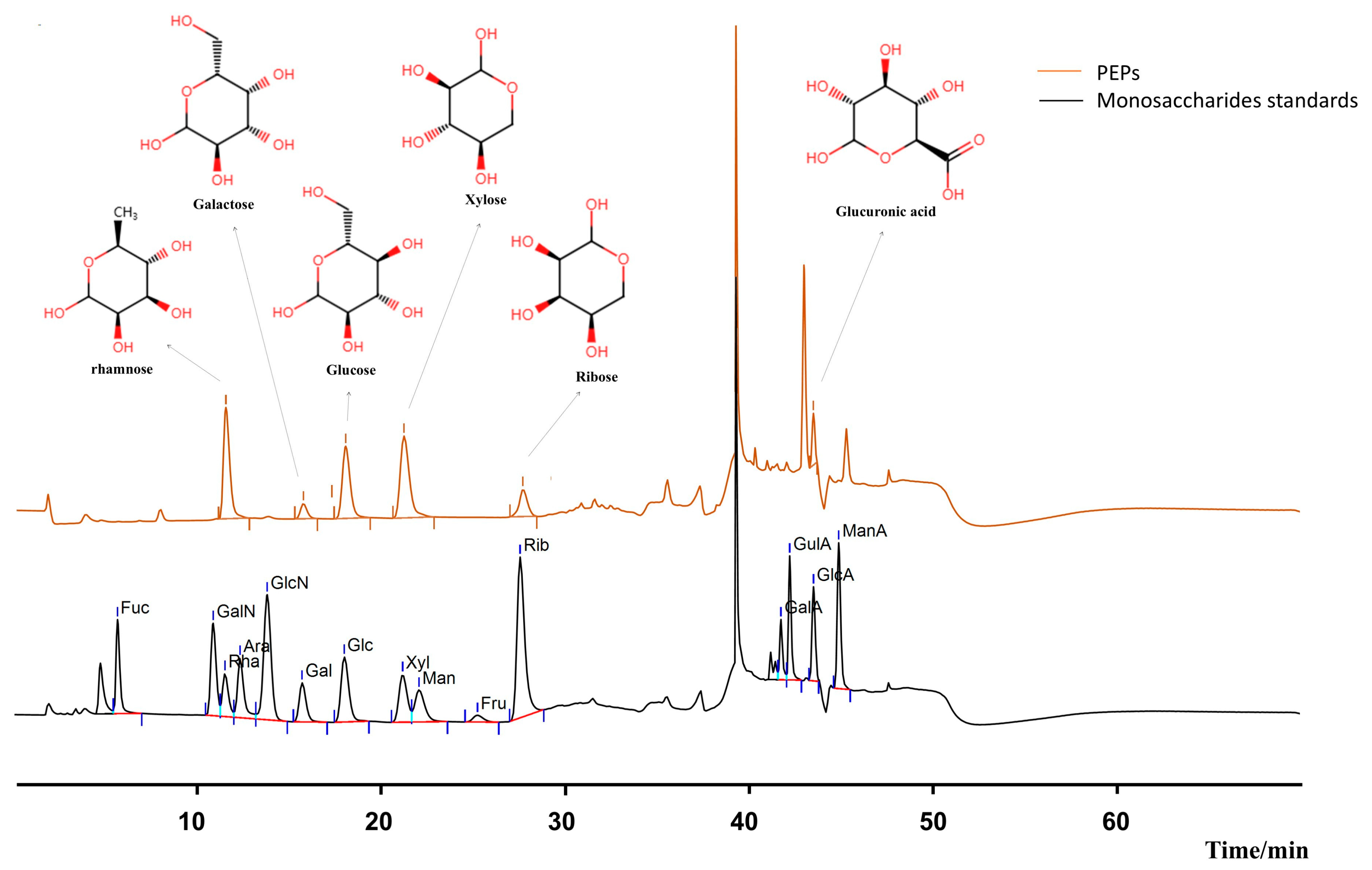

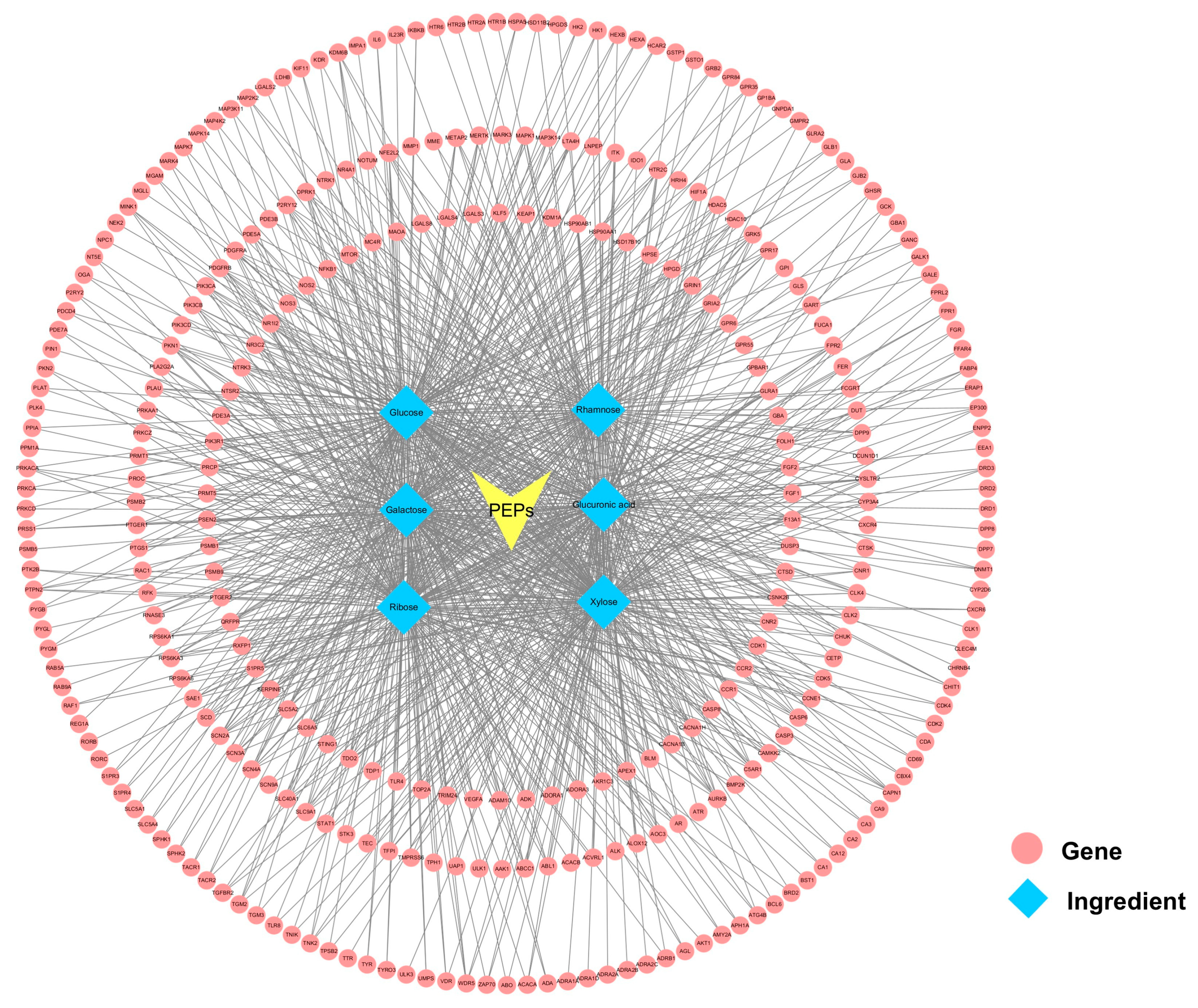

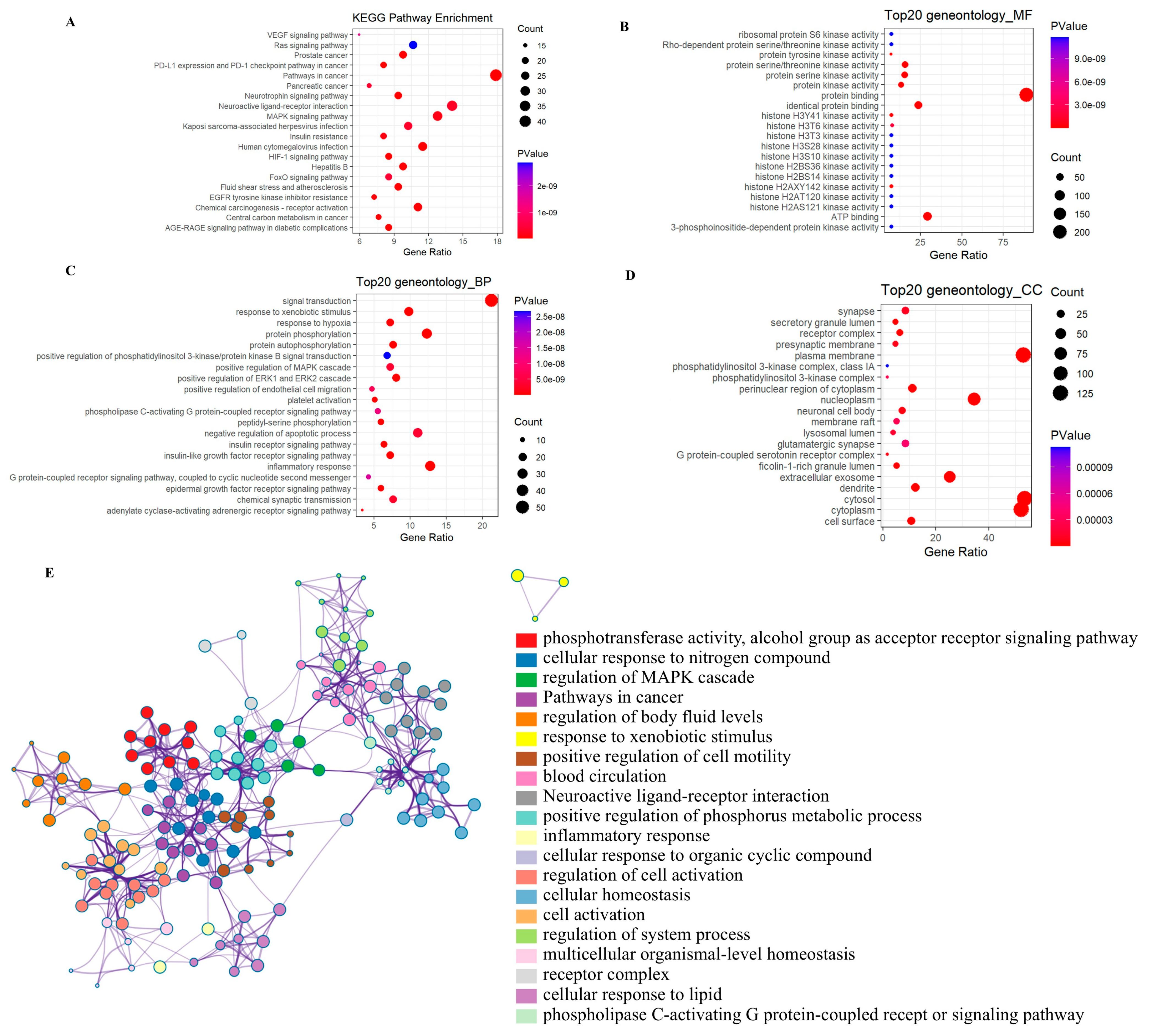

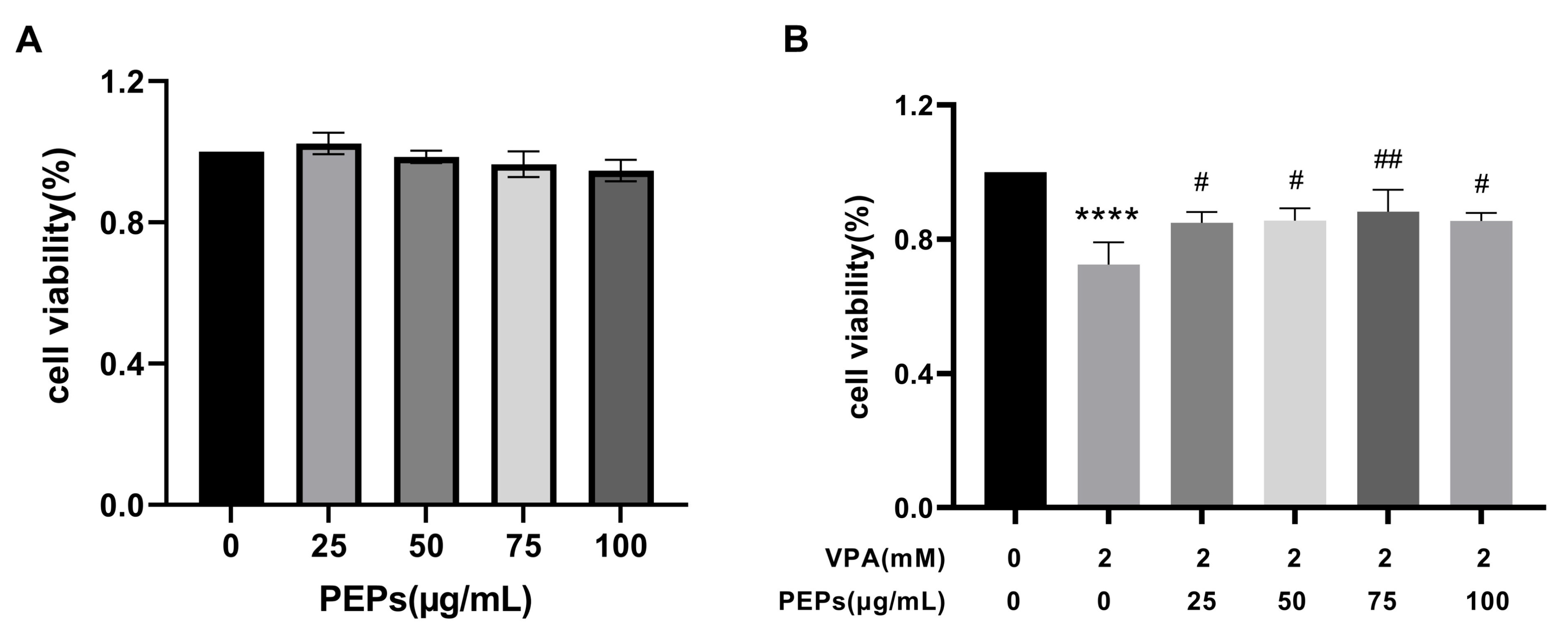

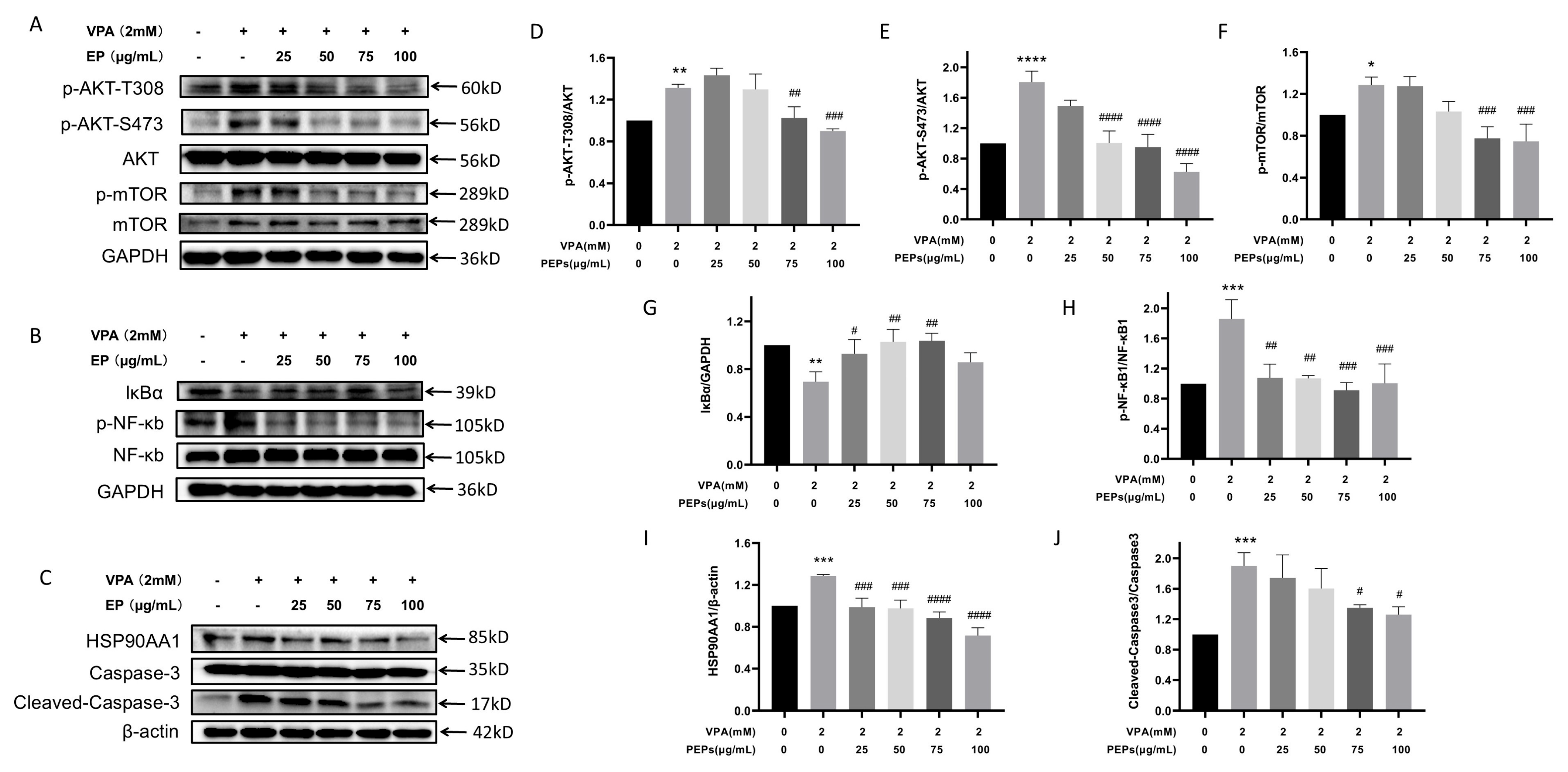
| Parameters | Treatment Conditions |
|---|---|
| Column temperature | 30 °C |
| Chromatographic column | DionexTM CarbopacTM PA20 (3 × 150 mm) |
| Mobile phase | A: H2O, B: 15 mM NaOH, C: 15 mM NaOH and 100 mM NaOAc |
| Current velocity | 0.3 mL/min |
| Injection volume | 5 µL |
| Gradient elution degree | 0~18 min (A:B:C = 98.8:1.2:0), 20~30 min (A:B:C = 50:50:0), 30.1~46 min (A:B:C = 0:0:100), 46.1~50 min (A:B:C = 0:100:0), 50.1~80 min (A:B:C = 98.8:1.2:0) |
| Detector | Electrochemical Detector |
| Peak Number | RT /min | Mp /kDa | Mw /kDa | Mn /kDa | PDI | Relative Peak Area % |
|---|---|---|---|---|---|---|
| 1 | 11.822 | 1535.617 | 1580.196 | 1884.417 | 0.839 | 16.081 |
| 2 | 16.188 | 3.972 | 3.813 | 4.687 | 0.814 | 83.919 |
| Rank | Gene Symbol | Degree | Betweenness Centrality | Closeness Centrality | Neighborhood Connectivity |
|---|---|---|---|---|---|
| 1 | CASP3 | 60 | 0.6396 | 0.6866 | 33.8833 |
| 2 | IL6 | 90 | 4.3283 | 0.5022 | 25.5667 |
| 3 | HSP90AA1 | 85 | 3.3474 | 0.5737 | 27.2588 |
| 4 | NF-κB1 | 60 | 1.3051 | 0.6196 | 33.8833 |
| 5 | HSP90AB1 | 67 | 1.6469 | 0.5385 | 31.0597 |
| 6 | AKT1 | 96 | 1.3130 | 0.6667 | 25.0625 |
| 7 | STAT1 | 52 | 0.5135 | 0.5385 | 33.7500 |
| 8 | mTOR | 60 | 1.2658 | 0.5385 | 33.4667 |
| 9 | HIF1A | 66 | 1.6616 | 0.6667 | 29.9697 |
| 10 | EP300 | 55 | 0.6798 | 0.5926 | 31.8364 |
Disclaimer/Publisher’s Note: The statements, opinions and data contained in all publications are solely those of the individual author(s) and contributor(s) and not of MDPI and/or the editor(s). MDPI and/or the editor(s) disclaim responsibility for any injury to people or property resulting from any ideas, methods, instructions or products referred to in the content. |
© 2025 by the authors. Licensee MDPI, Basel, Switzerland. This article is an open access article distributed under the terms and conditions of the Creative Commons Attribution (CC BY) license (https://creativecommons.org/licenses/by/4.0/).
Share and Cite
Zhou, X.; Su, H.; Chen, J.; Liu, L.; Zhou, Q.; Xia, X.; Wang, J. Enteromorpha prolifera Polysaccharides Alleviate Valproic Acid-Induced Neuronal Apoptosis in a Cellular Model of Autism Spectrum Disorder. Curr. Issues Mol. Biol. 2025, 47, 796. https://doi.org/10.3390/cimb47100796
Zhou X, Su H, Chen J, Liu L, Zhou Q, Xia X, Wang J. Enteromorpha prolifera Polysaccharides Alleviate Valproic Acid-Induced Neuronal Apoptosis in a Cellular Model of Autism Spectrum Disorder. Current Issues in Molecular Biology. 2025; 47(10):796. https://doi.org/10.3390/cimb47100796
Chicago/Turabian StyleZhou, Xulan, Hui Su, Jiaxuan Chen, Li Liu, Qian Zhou, Xiaochun Xia, and Juan Wang. 2025. "Enteromorpha prolifera Polysaccharides Alleviate Valproic Acid-Induced Neuronal Apoptosis in a Cellular Model of Autism Spectrum Disorder" Current Issues in Molecular Biology 47, no. 10: 796. https://doi.org/10.3390/cimb47100796
APA StyleZhou, X., Su, H., Chen, J., Liu, L., Zhou, Q., Xia, X., & Wang, J. (2025). Enteromorpha prolifera Polysaccharides Alleviate Valproic Acid-Induced Neuronal Apoptosis in a Cellular Model of Autism Spectrum Disorder. Current Issues in Molecular Biology, 47(10), 796. https://doi.org/10.3390/cimb47100796











